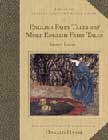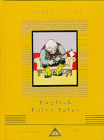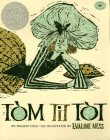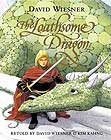| Introduction | Annotated Tales | eBooks | Bookstore | Illustration Gallery | Discussion Board | Blog |
 |
|
|
Reynard and Bruin Return to European Folk and Fairy Tales
by Joseph Jacobs YOU must know that once upon a time Reynard the Fox and Bruin the Bear went into partnership and kept house together. Would you like to know the reason? Well, Reynard knew that Bruin had a beehive full of honeycomb, and that was what he wanted. But Bruin kept so close a guard upon his honey that Master Reynard didn't know how to get away from him and get hold of the honey. So one day he said to Bruin, "Pardner, I have to go and be gossip -- that means godfather, you know -- to one of my old friends." "Why, certainly," said Bruin. So off Reynard goes into the woods, and after a time he crept back and uncovered the beehive and had such a feast of honey. Then he went back to Bruin, who asked him what name had been given to the child. Reynard had forgotten all about the christening and could only say, "Just-Begun." "What a funny name," said Master Bruin. A little while after, Reynard thought he would like another feast of honey. So he told Bruin that he had to go to another christening. And off he went. And when he came back and Bruin asked him what was the name given to the child, Reynard said, "Half-Eaten." The third time the same thing occurred, and this time the name given by Reynard to the child that didn't exist was "All-Gone." You can guess why. A short time afterwards, Master Bruin thought he would like to eat up some of his honey and asked Reynard to come and join him in the feast. When they got to the beehive, Bruin was so surprised to find that there was no honey left, and he turned round to Reynard and said, "Just-Begun, Half-Eaten, All-Gone. So that is what you meant. You have eaten my honey." "Why no," said Reynard. "How could that be?" I have never stirred from your side except when I went a-gossiping [serving as godfather], and then I was far away from here. You must have eaten the honey yourself, perhaps when you were asleep. At any rate we can easily tell. Let us lie down here in the sunshine, and if either of us has eaten the honey, the sun will soon sweat it out of us." No sooner said than done, and the two lay side by side in the sunshine. Soon Master Bruin commenced to doze, and Mr. Reynard took some honey from the hive and smeared it round Bruin's snout. Then he woke him up and said, "See, the honey is oozing out of your snout. You must have eaten it when you were asleep." Jacobs' Notes and References The main incidents of "Reynard the Fox" occur in folktales throughout Europe, and it has often been discussed whether the folk-tales were the foundation of the beast epic or vice versa. Since, however, it has been proven that many other incidents besides those used in the beast satire are found among the folk, it is generally allowed nowadays that, apart from a few AEsopic fables included in the satire, the main incidents were derived from the folk. On this subject see my introduction to "Reynard the Fox" in the Cranford Series. I have selected a number of the most characteristic of these folk-tales relating to the former friendship and later enmity of the Fox and the Bear, basing my compilation on the admirable monographs of Prof. K. Krohn of Helsingfors, "Mann und Fuchs," 1891, "Baer (Wolf) und Fuchs; eine nordische Tiermarchenkette," in Journal de la Societe Finno-Ougrienne, vi., Helsingissa, 1889, and "Die geografische Verbreitung einer nordischen in Finnland, " in Fennia, iv., 4. The latter monograph is accompanied by an interesting map of Finland, showing the distribution of the Scandinavian form of these stories, in which the Bear is the opponent of the Fox, and the Slavonic form in which the Wolf takes that position. As there is obviously a mythological tendency at the root of the stories, intending to account for the shortness of the Bear's tail and the white tip of the Fox's, it is clear that the Scandinavian form is the more original. I have tried to collect together in a logical narrative: (a) Fox and Bear in partnership (Top-off, Half-gone, All-gone). (b) Fox in fish cart. (c) Iced Bear's tail. (d) Fox and cream jug. (e) Fox on Bear's back. (f) Fox in briar bush. (g) Man promises Fox two geese for freeing him from Bear. (h) Gives him two dogs. (k) Fox and limbs; sacrifices tail. In his article in Fennia, Prof. Krohn refers to no less than 708 variants of these different episodes, of which, however, 362 are from the enormous Finnish collections of folk lore in possession of the Finnish Literary Society at Helsingfors. The others include the majority of European folk-tale collections with a goodly sprinkling of Asiatic, African and American ones, the last, however, being confined to "Uncle Remus," in which four out of the ten incidents occur in isolated adventures of Brer Rabbit. Many of the incidents occur separately in early literature; (g) (h) (k) for example, which form one sequence, are found not alone in Renard but also in Alfonsi, 1115, and Waldis. (c) The iced bear's tail occurs in the Latin Ysengrimus, of the twelfth century, in the Renart of the thirteenth, and, strangely enough, in the Hebrew Fox Fables of Berachyah ha-Nakadan, whom I have identified with an Oxford Jew late in the twelfth century. See my edition of Caxton, Fables of Europe, i., p. 176. The fact that ice is referred to in the last case would seem to preclude an Indian origin for this part of the collection. It is not quite certain however that all the above incidents were necessarily connected together originally. The fish cart (b), and the iced bear's tail (c), are so closely allied that they probably formed a unity in the original conception, though they are often found separately nowadays among the folk. Bear and Fox in partnership (a), is found elsewhere told of other animals, notably of the firm of Cat and Mouse in Grimm No. 2. It is difficult to determine at present whether stories relating to other animals, or even to associations of men, have been applied by peasant narrators to the general opposition of the sly versus the strong animal, which they have dramatized in the beast satire of Reynard and Bruin. For a discussion of the whole subject, see A. Gerber, Great Russian Animal Tales, Baltimore, 1891, who discusses the incidents included in the above compilation in his notes on v. (a), i. (b), ii. (c), iii. (d), iv. (e), iva. (f), ix. (g), x. (h), xi. (k). It will be found that few of the other incidents contained in Gerber can be traced throughout Europe except when they are evidently derived from AEsop. Jacobs, Joseph, ed. European Folk and Fairy Tales. New York: G. P Putnam's Sons, 1916. Return to European Folk and Fairy Tales by Joseph Jacobs |
|
| ©Heidi
Anne Heiner, SurLaLune Fairy Tales E-mail: heidi@surlalunefairytales.com Page created 4/15/05; Last updated 10/22/07 www.surlalunefairytales.com |
















